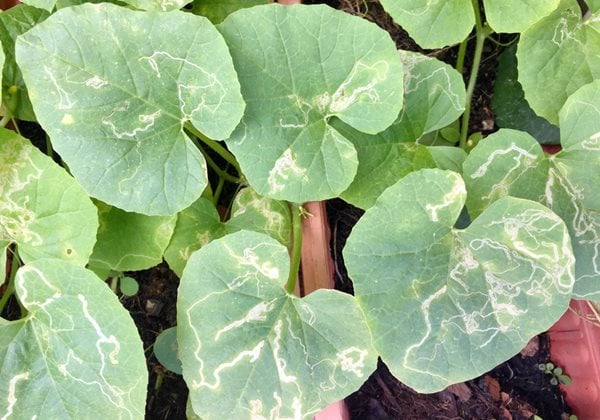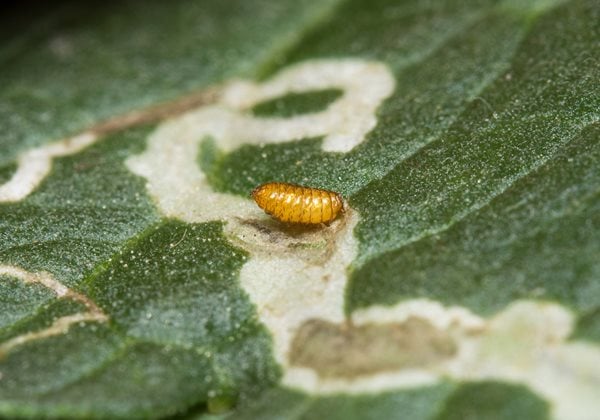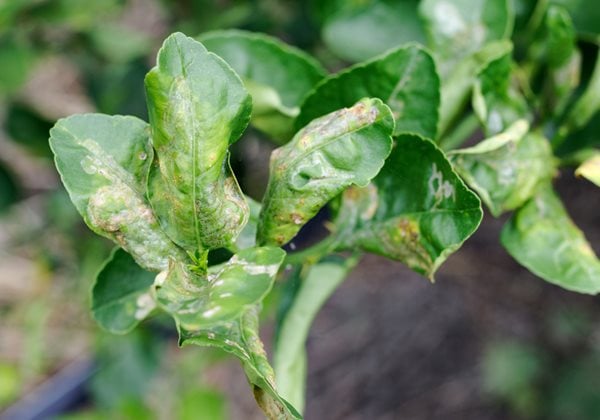How to Identify & Control Leaf Miners
Keep ornamental plants and edible crops healthy by controlling this garden pest
Leaf miner damage on watermelon leaves. Photo by: Thiti Sukapan / Shutterstock
Leaf miners are garden pests named for their habit of burrowing into leaves to feed on tender plant tissue. Leaf miner damage is easy to spot, characterized by squiggly trails that appear just beneath the foliage surface. The trails are translucent with white or yellow coloring, though leaf miner damage can also appear as splotchy patches on leaves.
These pests are found across the globe, most commonly on outdoor plants, though they can also occur in greenhouse and indoor environments. Different types of leaf miners have preferences for particular host plants over others. Since leaf miner damage has a distinct appearance and is readily apparent, control and prevention methods can be highly effective when infestations are dealt with early on.
Here’s how to identify and control this common garden pest.
On this page: What Are Leaf Miners? | Types of Leaf Miners | Leaf Miner Control | Prevent Leaf Miners | Recognize the Presence of Leaf Miners | Identify Damage | Plants Susceptible | Life Cycle of Leaf Miners
On this page:
- WHAT ARE LEAF MINERS?
- TYPES OF LEAF MINERS
- LEAF MINER CONTROL
- HOW TO PREVENT LEAF MINERS
- RECOGNIZE THE PRESENCE OF LEAF MINERS
- IDENTIFY LEAF MINER DAMAGE ON PLANTS
- PLANTS SUSCEPTIBLE TO LEAF MINERS
- LIFE CYCLE OF LEAF MINERS
WHAT ARE LEAF MINERS?
A leaf miner is not a singular kind of insect, but refers to larvae produced by insects from several different families that burrow and feed within the tissue layers of leaves. Most leaf miner larvae originate from various types of flies, though they can also come from moths and beetles. The adult insects lay their eggs on leaves, and larvae begin feeding as soon as they hatch, tunneling through plant tissue as they feed.
TYPES OF LEAF MINERS?
A typical leaf miner adult fly looks similar to common houseflies but smaller, about 1/15 to 1/3 inch long, with transparent wings and black, grey, and/or yellow coloring. Elongated white eggs .04 inches long are laid singly or in small clusters on the undersides of leaves. Segmented caterpillar-like larvae range from .02 to 1 inch long and can be brown, black, yellow, pale white, or green.
Two of the more common types of leaf miners found in home gardens are:
- Spinach leaf miner (Pegomya hyoscyami), which is a type of blotch leaf miner, creates irregular-shaped patches on leaves. Larvae are pale white with no obvious head or legs, and the adult flies are 1/4 inch long and gray or brown in color. This leaf miner feeds primarily on beets, chard, and spinach, but may also be found on other vegetables.
- Vegetable leaf miner (Liriomyza sativae) creates winding snake-like patterns on leaves. The yellow-green larvae are elongated with no apparent head or legs. Adult flies are 1/15 inch long with yellow and black coloring. Vegetable leaf miners feast on many different types of vegetables, including bean, beet, cucumber, eggplant, lettuce, onion, pea, pepper, potato, squash, tomato, and watermelon.
Other types of leaf miners include boxwood leaf miner (Monarthropalpusi flavus), chickpea leaf miner (Liriomyza cicerina), citrus leaf miner (Phyllocnistis citronella Stainton), serpentine leaf miner (Liriomyza huidobrensis) and tomato leaf miner (Liriomyza bryoniae).
LEAF MINER CONTROL

Leaf miner pupae. Photo by: Muddy Knees / Shutterstock
Check plants for eggs.
Carefully inspect the undersides of leaves, which is where leaf miner adults lay their eggs. Use a magnifier to more easily spot the tiny eggs.Remove leaves.
Cut affected foliage from plants as soon as damage is apparent and dispose in the trash rather than compost pile or yard debris bin.
Introduce or attract beneficial insects.
In a healthy ecosystem, leaf miners are usually controlled by natural enemies. Beneficial parasitic wasps (Diglyphus isaea) are a naturally occurring pest control that can be introduced to your yard to control leaf miner. The female wasps lay their eggs in the vicinity of leaf miner larvae, and the parasitic wasp larvae feed on leaf miners. Include dill, fennel, and yarrow in your garden, which will attract beneficial wasps.
Apply neem oil.
Use this organic method to kill leaf miner larvae. Spray affected foliage according to instructions and reapply as necessary until leaf miners are no longer present. (Read more about using neem oil.)
Avoid chemicals:
Use natural controls rather than synthetic remedies to treat leaf miner damage. Though there are synthetic pesticides that can be used to treat leaf miners, the use of these remedies is strongly discouraged. Chemical pesticides have limited effectiveness and should not be used on edible crops. Furthermore, these pesticides can harm beneficial insects that help control leaf miners and other garden pests.
Till soil.
Following the harvest of crops, till your garden to destroy pupae that are hiding in the soil.
HOW TO PREVENT LEAF MINERS
The most effective tool for controlling leaf miners is prevention. Here are some tips:
Examine plants regularly.
For susceptible plants and young seedlings, check plant leaves regularly for any signs of damage. Leaf miners occur more often on the first set of true leaves.
Inspect new plants.
Leaf miners are often introduced to home gardens through new plants. When purchasing plants from a nursery or garden center, carefully inspect the leaves for any leaf miner problem. Continue to monitor plants for 2 to 3 weeks after bringing them home, which is the typical life cycle of leaf miner larvae.
Keep plants healthy.
Healthy plants are more able to ward off pests and diseases.
Keep garden areas clean.
Some weeds such as chickweed, lamb’s quarters, and pigweed are a preferred food source for leaf miners, particularly in fall after other plants have gone dormant. Remove these weeds to reduce leaf miner populations.
Use row covers.
Install finely meshed row cover over vegetables to keep out leaf miners and other pests. If leaf miners were present during the previous growing season, row covers may not be effective, as pupae may still be residing in the soil.
Rotate crops.
Plant susceptible crops in different areas of your garden every year so that overwintering pupae are less likely to emerge close by.
HOW TO RECOGNIZE THE PRESENCE OF LEAF MINERS
Look for trails.
The easiest way to detect the presence of leaf miners is by the translucent patches or squiggly trails they leave on plant foliage.
Detect eggs.
Look at the undersides of leaves to see if you can spot any eggs, which will appear as clusters of tiny oval white specks.
Look for larvae.
In the area of trails and splotchy areas, you may spot the worm-like larvae which will be burrowed just below leaf surfaces.
IDENTIFY LEAF MINER DAMAGE

Citrus leaf miner damage on lime tree leaves. Photo by: Kritchai7752 / Shutterstock.
As leaf miner larvae feed, they create tunnels or mines between foliage layers, leaving behind dead plant tissue. These mines start out opaque, eventually turning brown. The amount of damage tends to be minor and mostly cosmetic, but can be particularly destructive to edible leaf crops such as lettuce and spinach.
It’s rare for infected plants to die as the result of leaf miner damage, though repeat infestations can weaken plants and make them more susceptible to leaf drop, as well as other pests and diseases. Smaller plants and seedlings are more prone to severe damage. For edible leaf crops such as lettuce and spinach, untreated damage can result in the loss of an entire crop.
PLANTS SUSCEPTIBLE TO LEAF MINERS
Food crops preferred by leaf miners include leafy crops such as kale, lettuce, spinach, beet greens, and Swiss chard. Leaf miners will also attack the foliage of other vegetables such as beans, beets, blackberries, cabbage, celery, cucumber, eggplant, melons, peas, peppers, potatoes, and tomatoes. Leaf miners rarely if ever cause damage to the fruits or vegetables since they prefer feeding on foliage.
Ornamental plants more likely to be affected by leaf miners include aster, baby’s breath, chrysanthemum, columbine, dahlia, daisy, dianthus, marigold, petunia, sunflower, violet, and zinnia. Trees and shrubs at risk include arborvitae, aspen, azalea, boxwood, citrus, cottonwood, dogwood, elm, hawthorn, lilac, and oak.
LIFE CYCLE OF LEAF MINERS
The pupae of leaf miners overwinter in garden soil near preferred plants. In spring, the pupae develop into adult flies, which begin laying eggs in April and May. Female flies produce up to 250 eggs, depositing them on the undersides of leaves.
Once eggs hatch in 2 to 6 days, leaf miner larvae emerge and begin feeding and tunneling through the middle layer of leaf tissue, staying just below the surface. The larval stage lasts for 2 to 3 weeks until larvae drop to the ground, where they develop into pupae. In another 2 weeks, the pupae become adult flies. The entire life cycle takes 30 to 40 days and can repeat several times during the growing season.
RELATED:
Garden Pests & Diseases
Getting Rid of Japanese Beetles
How to Get Rid of Grub Worms
